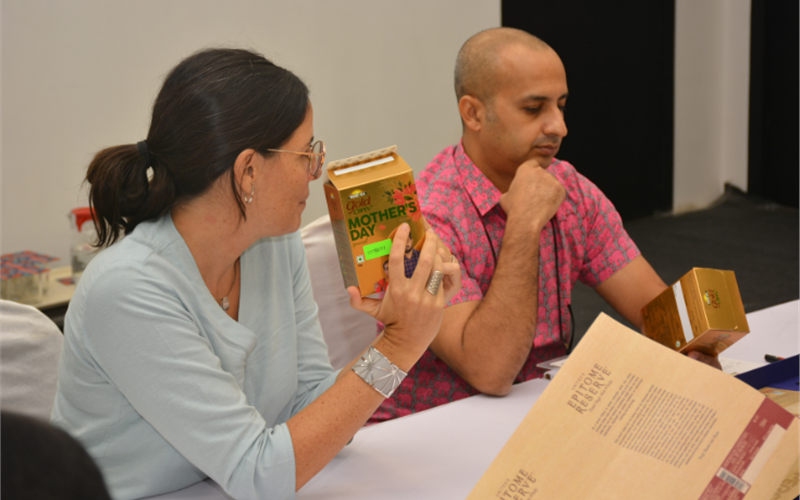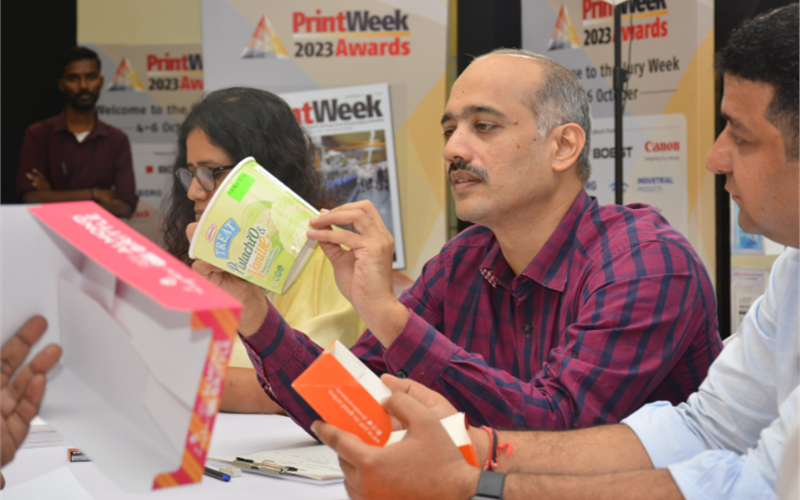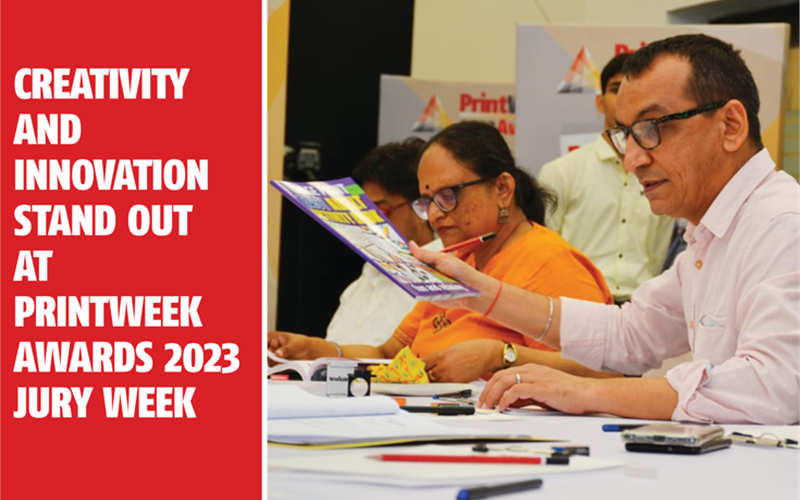Creativity and innovation stand out at PrintWeek Awards 2023 Jury Week - The Noel D'Cunha Sunday Column
More than 700 individual print samples for the Quality Awards in 18 categories reveal how printers and packaging converters are using the latest technology to create innovative products, which are also sustainable. PrintWeek reports.
Read more in this Sunday Column
14 Oct 2023 | By Noel D'Cunha
The Jury Week for PrintWeek Awards 2023 was held on 4-6 October at The Studio located in the Haymarket Sac headquarters in Voltas Premises in Mumbai.
Unlike the previous editions of the show, where Jury Day was a daylong affair, this year, it has been spread across three days so that respective Juries get more time to evaluate the samples received for the Awards and discuss the tech-specs and innovations as well as specialisatons in greater detail.
The Awards recognises the very best of printing, whether it’s innovation, quality, or out-of-box approach to the medium, in 33 categories across Performance, Quality, and Special Industry Awards. There are 18 Quality Awards, 11 Performace Awards and 4 Special Industry Awards.
This year, the Awards received more than 700 samples for the Quality Awards. For the Jury Week event, the categories were divided into three groups. There were separate sets of Jury members on each day.
All print/packaging jobs were coded and the identity of the company was kept secret. The Jury carefully reviewed the entries, discussed their choices with their fellow Juries, who are experts in their fields, and then made the final selections.
On the first day of Jury Week, the members included Dibyajyoti Sarma; Mukund Moghe; Naju Hirani; Praful Akali; Rajnish Shirsat; Sudha Ganapathi and Surendra Babu. The seven members judged the samples submitted in seven categories.
On day two, the Jury team comprised Elodie Nerot; Geet Nazir; Neeharika Paul; Nikhil Phadke; Ritesh Uttamchandani; Supreeth Sudhakaran and Yatin Patil. They judged samples in seven categories. This included two Innovative categories.
On day three, Jury members Amit Saurkar; Deepti Kshirsagar; Fazal Farooqui; Pratik Rane; Raju Kalgutkar; Sheetal Dandekar and Soma Roy judged the samples for five categories which included the heavyweight packaging categories.
Jury Week Day One
Commencing on the samples on the first day, which focused on books and commercial printing, Rajnish Shirsat, co-founder and CEO, R&S Enterprises, said, “The quality of work has gone up drastically with a lot of small players from small towns emerging. This is a great sign for the industry. I observed the post-press improving with many value-additions and neat finishes.” He added, "Digital printing has improved tremendously, and different papers used for book production and the consistency in printing were impressive."
According to Mukund Moghe, senior manager, brand and production, Tata Services, the key trends he noticed were the dominance of digital technology, sustainability, short-run printing and hybrid printing. He was also impressed by how RFID technology is being used in the printing industry, particularly for packaging and labelling. “RFID tags embedded in printed materials enable tracking, authentication and enhanced supply chain management,” he said.
He added, “Sustainability has become a significant concern in the print industry. Technologies and practices that reduce waste, energy consumption and environmental impact have gained attention. This includes the use of eco-friendly inks, recycled paper and advanced printing techniques that minimise resource usage.”
Moghe said in 2023, the print industry has been handling the challenge of sustainability with aplomb. “Sustainability has become a paramount concern due to increasing environmental awareness and concerns. The printing industry has been addressing this challenge by adopting various techniques to reduce waste, usage of environmentally friendly materials, increase energy efficiency, digitalisation and most importantly, regulatory compliance,” he said.

Once upon a time, a majority of books were being produced in China. In the past few years, India has been a solid competition. Shirsat said the biggest challenge used to be pricing. Now, it is all about finding book suppliers who can deliver as per strict deadlines. “And finally, if you look at the work that was displayed during Jury Week, the books have lots of complexity and need much embellishment. Some of the Bible books and education books that Indian book print firms are producing are amazing,” he added.
Moghe said, “In the Indian book market, getting a competitive price is not really a problem. We used to struggle with service support and tech support. Sometimes a jobber or a canvasser provides superior support and turnaround than a big book print firm. The response time has to come down. This is a big challenge that the book manufacturing industry has to address.”
According to Surendra Babu, books are a good growth market in India. There are textbooks and academic books which are growing. “But what the Awards indicated was specialised, POD with beautiful finishes: books that people will buy and pay well for. Meanwhile, the definition of big volumes is changing. This does not mean books are not necessarily being printed. I think many more varieties of books are being produced. And Indian book print firms are producing them with greater efficiency.”
Freelance designer Naju Hirani said that titles are also moving from offset print to digital print. “I do find it frustrating that people think there are no manufacturing costs involved in digital print though. There are – just look at the massive investments publishers have made in digital infrastructure.”
Dibyajyoti Sarma of Red River agreed, “Obviously digital media is having a big impact on both the book and education sectors. We still don’t seem to have nailed the piracy issue. We seem to be just ignoring it because it’s not a problem right now. Sometimes, we feel that we haven’t learned the lessons from the music industry. Then there are things like Amazon’s ‘lending library’ or what Repro India is doing. I feel this is going to impact us.”
Praful Akali, founder & managing director, Medulla Communications said books are creative and inspiring and we get to do it often. “The finishing and binding to develop a product is superb. And the amazing thing is, once one book is finished, the book print firm starts all over again and works hard to make the next even better than the last. It doesn’t get much better than that.”
Sudha Ganapathi, chairperson & manager, publications unit, TISS, concurred, “Yes, books are the best.”

Jury Week Day Two
What impressed the Jury most on day two was the thought processes behind the designs of the samples, and the printing and matt, gloss, and adhesion to make the products stand out. The three big trends which stood out on day two were: four process colours, with minimum two Pantone colours, along with one special post-press operation; greater control over the pre-press which ensures easier production (almost all ops inline); and short runs with the “sweet spot” lower and lower. The simplicity of the technology and the small footprint have enabled more and more ops to be rendered in-house.
The jury members were particularly impressed with short-run labels being printed digitally with special post-press augmentation. There were entries with intricate die-cuts, cold foil and de-embossing. There were labels with invisible inks and glow-in-dark. There were pouches with biodegradable materials. There were packaging structures which were child-proof or easy for the senior citizens to use.
There were many samples like self-adhesive labels, cartons, pouches and wraparounds. What grabbed the eye of the jury members was: lightweighting versions of the same product; usage of low-migration compliant inks for indirect packaging; printing on the reverse side of shrink sleeve applications.
The Jury members were especially impressed with the anti-counterfeiting measures used in the samples, from the simple QR codes and barcodes to invisible inks to holographic effects. Also, high-end cartons featuring special finishes and metallics. Plus complex labels with multiple processes and hybrid screening.
The Jury also noted how the prevalence and availability of technology have inspired traditionally small and not-so-market-savvy brands to experiment with innovative packaging design. A quiet sort of revolution seems to be brewing in the segment, where all brands whether big or small, corporate or family-run, are able to find new ways to present their packages, with added enhancements because the technology is available and at a competitive rate.
Elodie Nerot, creative director, Elephant Design, said, “The samples we saw today highlight how packaging converters are pushing the boundary of what is traditionally possible in print. It was a revelation for me. I was excited to witness the different possibilities of packaging design.”
Neeharika Paul, packaging transformation master, PACKult Studio, said, “I liked how micro-foiling has been used to enhance the tactile feel of the labels and the packages.”
She also highlighted the user-friendly aspects of some of the samples, and how the packages themselves invite the user to use the product better.
Yatin Patil, manager, engineering & NPD, Desworks by Bizongo, said, “I was very excited to see how flexo is evolving alongside gravure. There is still a minor difference in quality, but I think flexo will catch up. Another thing I liked was how the converters are using anti-counterfeiting measures such as invisible inks, holograms, barcodes and QR codes.”
Today, QR codes are popping up everywhere, there is a 4,000% increase in the segment increase in their use in the Indian market in the last two quarters. Some of the samples for the agro sector were customised for the farming community. There is less text and much more videos, farming tips and audio apps.
Freelance photographer Ritesh Uttamchandani, said, “For me, it was a complete revelation. For me, as a common user of consumer products, getting to see the thought process behind packaging was an eye-opening experience.”
Uttamchandani was also impressed by the work in the Fine Art Category as well as the kind of photo wedding albums which are being created.
Nikhil Phadke, creative director, Elephant Design, said, “I was impressed with the different printing technologies and the use of non-traditional substrates. Today, we can use so many different shades and hues, even in shorter runs, which was almost impossible until a couple of years ago.”
Supreeth Sudhakaran, group communication and brand, Aditya Birla Group, said, “There were so many innovative samples, it was a learning experience. I especially appreciate how the post-press embellishments were unintrusive and at the service of the brand, not the other way around. Today many print firms and converters require self-adhesive labels for bottles. This is a move away from the more traditional wet labelling process. Besides increasing the bottling speeds there is a huge improvement in the quality of the label too.”
Geet Nazir, managing partner, Conran Design Group said, "Sustainability has become a focus area and it is good to see the industry endeavouring towards achieving it. Ultimately the solutions for sustainability, resource efficiency and recycling and reuse will come from the print and packaging industry. This will encourage and enable brands and customers to convert to the new formats; and help them to meet their sustainability commitments fast."
Noel D'cunha, managing editor of PrintWeek and WhatPackaging? magazine said, "The highlight of Day Two was to see converters and label print firms team up with materials manufacturers to advance the use of alternatives to plastic packaging. Earlier this was a utopia, today we saw industrial production. Potential applications included sachets, pouches and stand-up pouches as well as labels and cartons." He alluded to samples which were designed to be in direct contact with food products and has achieved the necessary barrier properties without the use of plastic film. Also use of eco-friendly coating process that results in a product that is free from PE, PVC, PET and polypropylene and can be reprocessed in existing paper recycling systems.”
All the jury members concurred that the Jury Week is a wonderful opportunity for customers, brands and suppliers from across the eco-system to meet and share solutions, as well as develop new ideas to help solve key industry issues and create new opportunities.

Jury Week Day Three
On day three, the Jury team comprising seven veterans from the industry went through 250 plus samples received in five quality categories which focussed on packaging in the F&B, FMCG, pharma, rigid box, paper bag and textile. According to the Jury, the industry is much ahead of the technological developments and is courageously innovative.
The Jury members were impressed by the versatility of the packaging materials used. There were samples that deployed 100% recycled material, rPET and rPP. What impressed the jury was the percentage of the recycled used, the physical properties achieved and the stability of the packages.
Deepti Kshirsagar, chief design strategist, TCT Strategic Branding, said, “Being from a creative field, initially I was expecting some good designs. But when I started discussing with the jury members, I was amazed by the speciality ink features. What blew my mind was the ink that gives a funky radium effect when UV light is passed through it. Also the experimentation with multiple substrates as well as the structure of the packaging item.”
She added that embossing, foiling, innovative product design, new materials or inks have become accessible even for brands which did not have budgets for packaging. There were samples for a Mysore Pak brand in Karnataka as well as a snack brand from Pune, and the point is, it was not merely a four-colour job with a basic carton.
She said, “For a great many product areas though, some form of embellishment is needed and desired and so converters are being tasked with delivering that at an affordable cost point. They are tackling the issue in a number of ways, beginning with getting involved in the design process before the final product decisions are made.”
Raju Kalgutkar, head of packaging, consumer products division, Piramal Enterprises, said, “I saw a lot of progress in printing. I noticed a lot of CI flexo jobs. There was one sample that was a hybrid of flexo plus offset printing. It was a difficult process judging the samples because a lot of them really impressed us.”
So much has changed in CI flexo preses, especially when setting up impression and register, that even as a brand, I know I can cut down waste on substrates, ink, solvent, energy and machine time. In addition, since the whole process is fully automatic and not influenced by variables such as operators, ink variations or the interval between repeat orders, one gets the same print results every time.
Amit Saurkar, head, packaging development, MTR Foods, said, “I am happy to be back as part of the PrintWeek Awards Jury. Another year of excellent samples and it is astonishing to see that the industry is trying something new every day. And not to forget, everything we judged today has been commercialised.”
Faced with the combination of a cut-throat, time-sensitive, brand-conscious new-age Indian consumer and the plethora of product choice competition crowding the retailer shelves, the brands (big and small) are increasingly under pressure to shout to make themselves heard. Saurkar said, “Design, print and packaging have been evolving and are evolving for good.”
Another Jury member added, “I like how brands are aware of counterfeiting and we can see that the brands are actively trying to find suitable solutions for these products.”
There were holograms and QR codes as well as the spirograph-like patterns which are usually seen on bank notes. Also, lots of improvements have been made to the UV preview, special raster functions, and tech-wizardry to prevent copying by using two colours. There are many more combinations to increase the level of security. It makes the creation of packaging items simple, yet highly secured, and ensures anti-counterfeiting is brought to the next level.
Sheetal Dandekar, senior general manager, JB Chemicals, said, “Once designed, your product goes through a lot of processes and treatments. And in a few cases, the final packaging and the design that was created do not match. We see this as a challenge, and the good part is that we are actively trying to curtail the difference.”
Soma Roy, lead, packaging development, Bajaj Electricals mentioned during the discussion that the industry is doing a good job by trying to experiment with new materials, and new printing techniques as well. She said, there are truly universal challenges around productivity, profitability, sustainability and volumes. In partnership with some of the companies whose samples she saw, she said, she could see how companies in this sector are tackling some of these challenges.
Fazal Farooqui, director of strategic partnerships, Packfora, said, “I have been a part of this process for quite some time now. I believe the pharma industry is using a lot of techniques to prevent duplication which is quite impressive.”
This includes miniature booklets. In addition to folding, pharma specialists have added a perforated adhesive tab to each booklet. The tab seal is designed to keep the miniature booklets closed until the customer needs to read the contents, as well as allow for easy mechanical insertion.
All the jury members concurred that the creation of a circular economy begins in the R&D process. This includes using sustainably sourced materials in product design and packaging, while incorporating ethical working practices throughout the manufacturing process. All the jury members said, this has become important since young customers are asking questions before they end up buying.
The PrintWeek Awards 2023 partners are Bindwel; Bobst India; Boxtech Bangalore; Canon India; Esko; Farb Technologies; Focus World Tours; Heidelberg India; Hi-Tech Inks; Indas Analytics; Kala Jyothi Process; NBG; Orient; Pidilite; Pratham Technologies; Sangeeta Poly Pack; SigLoch; Sona Papers; Stelda; TechNova; and Vinsak.
The 13th edition of the Awards ceremony will be held on 30 October 2023 at The Westin Mumbai Powai Lake.












 See All
See All